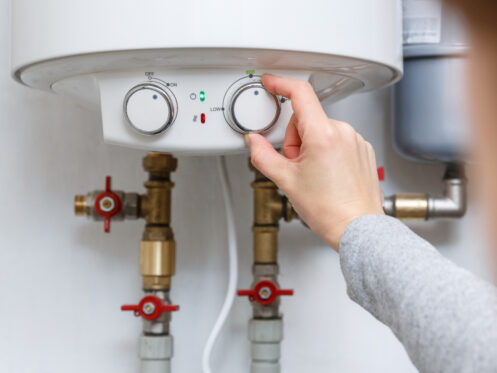It’s easy to take hot water for granted until you don’t have it. Fortunately, water heaters rarely fail unexpectedly. That is why knowing the warning signs that your water heater is about to fail is critical. If you understand how to recognize these signs, you can prevent discomfort, inconvenience, and water damage when the water heater fails.
1. Lack of Sufficient Hot Water
This is a key indicator of a failing water heater. Residue buildup in the tank can insulate the heating element, reducing its capacity. A malfunctioning heating element or a faulty thermostat may also lead to insufficient hot water. Additionally, rust inside the tank can hinder the heating process. If you notice a consistent reduction in the amount of available hot water, especially when the demand hasn’t increased, it’s a clear sign of potential issues with the water heater.
2. Strange Noises
Strange noises emanating from your water heater often signal impending issues. Popping, banging, or rumbling sounds are typically caused by sediment buildup within the tank. Minerals and other particles settle at the bottom of the tank, forming a layer of sediment. During heating cycles, this sediment hardens and causes the tank to make rumbling, cracking, or popping noises.
A few things can contribute to a hissing or whistling sound. If cracks or fissures are within the heater, the sound can be made from steam escaping through these openings. Higher-pitched sounds may be from water under pressure flowing through a constricted valve or pipe.
Regular flushing of the tank to remove sediment and promptly address cracks can prevent further damage to the heater. However, persistent strange water heater noises might indicate a more severe problem, requiring a professional water heater inspection to determine if repair or replacement is necessary.
3. Discolored or Rusty Water
Discolored water emerging from faucets is a significant indication of a deteriorating water heater. Brown, reddish, or muddy-colored water can indicate a rusting tank. Hot water tanks have an anode rod to help prevent rusting. When this rod is used up, it leaves the tank vulnerable. If a rusting tank is unaddressed, it can lead to leaks or even tank failure.
To troubleshoot this issue, check water from both hot and cold taps; if only the hot water shows discoloration, the water heater is likely the culprit. Consulting a plumber can help diagnose and resolve these issues effectively.
4. Leaking Water Heater
This is another significant red flag indicating potential failure. Typically, water leaks indicate tank corrosion or damage. Over time, the tank’s metal can deteriorate due to constant exposure to water and heat, leading to tiny fractures or holes. The pressure buildup from heating water exacerbates these weak points, causing leaks.
A leaking water heater demands immediate attention as it can result in property damage, mold growth, or electrical hazards if the water reaches electrical components. Addressing this issue is essential: turn off the heater, contain the leak, seek professional help to diagnose the source of the leak, and take necessary repair measures. Depending on where the leak is, repair may be possible.
5. Foul Smell in Hot Water
As mentioned, the anode rod helps protect the tank from rusting. These rods usually last several years before they need replacing. When the anode rod is failing, you might notice a rotten egg smell coming from the tap water. This is the time to call for repairs before the inside of the tank starts to rust.
6. Fluctuating Temperatures
Several issues can cause inconsistent water temperature in your water supply. Silt accumulation at the bottom of the tank can insulate the heating element, leading to uneven heating and temperature fluctuations. A malfunctioning thermostat may inaccurately control the water temperature, causing sudden shifts in hot water availability.
Additionally, a damaged dip tube, which directs incoming cold water to the bottom of the tank, can result in a mixture of hot and cold water, creating temperature irregularities. Addressing these issues might involve purging the tank, replacing faulty components like the thermostat or dip tube, or even considering a new water heater if the problems persist.
7. Frequent Repairs
Over time, wear and tear take a toll on its components, making it more prone to breakdowns. Repeated breakdowns or the need for consistent fixes suggest underlying systemic issues. Persistent problems like leaks, heating element failures, or thermostat malfunctions often indicate the heater’s deteriorating state.
While occasional maintenance is normal, frequent repairs signify deeper problems and potential imminent failure. Considering the cumulative cost and inconvenience of repairs, investing in a new water heater for a reliable, cost-effective, and hassle-free hot water supply might be more prudent.
8. Increased Energy Bills
As a water heater ages or encounters issues, it becomes less efficient. It requires more energy to produce the same amount of hot water. For instance, damaged or worn-out heating elements struggle to heat water efficiently, requiring prolonged heating periods and increased energy consumption. Unexpected energy bill spikes can be an early warning sign of a failing water heater. Replacing or servicing the heater can help restore energy efficiency, preventing further financial strain from escalating utility costs.
9. Loud Noises in the Walls
If you hear hammering or similar loud noises in the walls whenever you open a hot water tap, the pressure valve is the likely culprit. Pressure valve issues in a water heater pose significant risks. The temperature and pressure relief valve (TPR valve) regulates internal pressure by releasing excess pressure to prevent tank explosions. If the valve malfunctions or operates irregularly, it could lead to potentially hazardous situations.
A faulty TPR valve might cause constant dripping or leakage, indicating high pressure inside the tank. Conversely, excessive pressure can build up if the valve fails to open when needed, risking tank rupture. Regular testing and maintenance of the TPR valve are crucial; it should release small amounts of water during testing. Any signs of continuous leakage or irregular operation mandate immediate professional attention to prevent catastrophic failures.
10. Age of the Water Heater
Typically, a standard tank-type water heater lasts around 8 to 12 years. As the unit ages, wear and tear become prevalent, leading to diminished efficiency and increased likelihood of malfunctions. Corrosion weakens the tank, increasing the risk of leaks or ruptures. Aging heating elements, and other components can reduce heating capacity and cause frequent breakdowns. Considering the age of your water heater is vital. Replacing it can prevent sudden failures and ensure a dependable and efficient hot water supply as it nears or surpasses the average lifespan.
Are you looking to maintain a consistent hot water supply? Act upon any observed signs of a failing water heater promptly. Prioritize your home’s safety and efficiency by scheduling a professional inspection with us at Wild West Plumbing, Heating & Cooling. We have served Kalispell, MT and the surrounding areas since 1986 with 24-hour emergency plumbing, heating, and cooling services. Reach out to us today at Wild West Plumbing, Heating & Cooling for more information.

